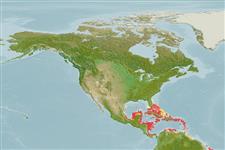Preferred temperature (Ref.
123201): 27.1 - 28.3, mean 27.9 °C (based on 311 cells).
Phylogenetic diversity index (Ref.
82804): PD
50 = 0.5000 [Uniqueness, from 0.5 = low to 2.0 = high].
Bayesian length-weight: a=0.00724 (0.00339 - 0.01546), b=3.10 (2.92 - 3.28), in cm total length, based on LWR estimates for this (Sub)family-body shape (Ref.
93245).
Trophic level (Ref.
69278): 3.0 ±0.3 se; based on size and trophs of closest relatives
Widerstandsfähigkeit (Ref.
120179): hoch, Verdopplung der Population dauert weniger als 15 Monate. (Preliminary K or Fecundity.).
Fishing Vulnerability (Ref.
59153): Low vulnerability (10 of 100).
Nutrients (Ref.
124155): Calcium = 443 [185, 1,497] mg/100g; Iron = 1.8 [0.7, 4.2] mg/100g; Protein = 17.6 [15.4, 19.5] %; Omega3 = 0.105 [0.032, 0.334] g/100g; Selenium = 41.2 [10.6, 135.5] μg/100g; VitaminA = 91.5 [15.8, 481.7] μg/100g; Zinc = 4.82 [2.49, 8.31] mg/100g (wet weight);
